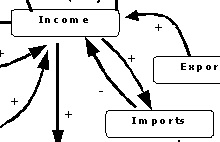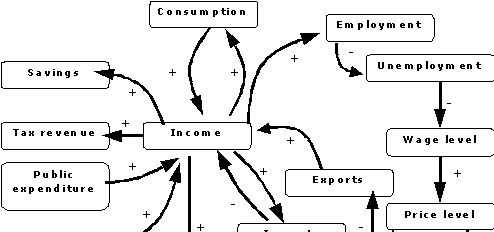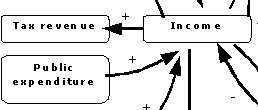| 4.2.
Fiscal cuts |
|
|
GDP
is the sum of public expenditure, consumption,
investment and net exports; thus any
fall in any of these variables will have a negative impact on it.
Accordingly, a cut in public expenditure,
however decided and other things equal, has a direct impact on GDP, reducing
it, with a movement in the same direction (sign "+" in our graph).
The fall in income (GDP) may be due to a decrease in production of goods
and services previously bought by the public sector and/or due to a direct
reduction in the number of civil servants. |
|
|
At any
rate, a fiscal cut reduces income of households.
This, in turn, reduces their consumption,
because they have less to spend.
The reduction in consumption has the further effect of reducing income,
triggering a vicious circle, so strong in the '30s of the last century that
it was "discovered" and conceptualised by authors of that age
(Kahn and Keynes). Since then, this vicious (or virtuous - if it works the
other way round!) circle is known as the Keynesian multiplier. |
|
|
The on-going
fall in income reduces employment as
well, since less labour is required for productive aims. |
|
|
Household
savings will go in the same direction
as income, so that they will fall.
Even more importantly from the point of view of the decision-makers, they
should know that the tax revenue will
shrink, since the tax base (income, value added...) goes in this direction.
If for example the public expenditure cut was justified by the necessity
of reducing the public deficit (tax revenue
less public expenditure), it is clear
that the parallel fall in tax revenue makes this objective much farther.
|
| All the
changes we saw after a cut in public expenditure are usually considered
as negative. But in the economy, at each negative side often correspond
a positive element somewhere else. |
|
|
In fact, the fall in income reduces the real interest
rate, through a reduction of money
demand for transactions.
The fall in real interest rate should increase investment, braking or even
inverting the income reduction.
|
By the
same token, the reduction in the real interest rate implies a fall in the
nominal exchange rate, to the extent
the latter is free to float and move.
The devaluation in both nominal and real exchange rate will improve the
international price competitiveness of the economy, fostering exports and
depressing imports. |
|


|
Imports
can play an extremely important role in inverting the business cycle.
They immediately fall as soon as income goes down. They further fall due
to devaluation. This is conducive to a boost of domestic production which
outperform general income dynamics, exactly because of substitution of imports
(and new positive dynamics of exports). |
|
If investment
and net export dynamics are sufficiently strong, the initial fall in income
will be reverted, the Keynesian multiplier will begin to work in the growth
direction and the public expenditure cut will be fully compensated (in
a macroeconomic perspective).
|
|
|
To a similar
scenario can contribute also a fall in the absolute price
level: to the extent the on-going reduction in employment and the symmetric
increase in unemployment will reduce
the absolute level of wages, the firms
may decide to reduce prices.
This would increase the real money supply and further reduce the real interest
rate, as well as improve the international price competitiveness with a
fall in real exchange rate. |
In this
complex dynamics, it is pretty clear who are the losers: the households
saw reduced their income, shrinked employment, and lower wages. In particular,
families relying on public expenditure would be in the front line.
Another relatively clear thing is the possibly marginal role of the central
bank. In all we saw, we could simply imagine that the nominal money supply
was unchanged, with no work for the central banker. |
|
|
Only if
he decides so, the central bank can influence the cycle. If the public expenditure
cut is immediately connected with an increase of the money supply, the consequent
fall in the interest rate will anticipate the positive effects on investment
and net export we previously saw as linked to a GDP painful fall.
In this way, the cut is immediately compensated and the Keynesian multiplier
needn't to be activated in the depressive direction, as well as there will
be no negative impact on the total level of employment.
Since the tax base will be nearly unchanged, the State deficit will neatly
improve. |
| If by contrast
the central bank decides to reduce the money
supply, the increase in the interest rate will be sudden and extremely
strong. |
| [See previous
graph] |
Investment
and net export will shrink and the GDP, receiving depressive pressure from
every side, will severely contract. |
 |
Mass unemployment will be the dominant
feature of the system. Deflation is the consequence, but the fall of price
is hardly capable to invert the trend.
Notwithstanding the initial expenditure cut, the state deficit will worsen
because of the induced chain of events. |
|
The recovery isn't guaranteed until
a policy change is imposed.
|










